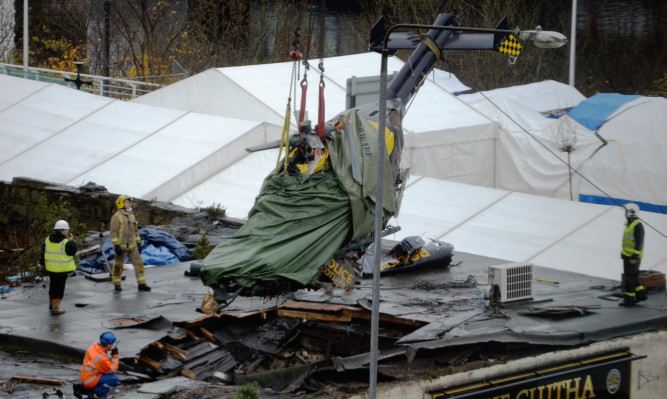The manufacturer of the helicopter which crashed into the Clutha pub is updating its maintenance manual after the report into the tragedy found an error.
The Air Accidents Investigation Branch (AIBB) report into the crash which killed 10 people found there was just 32 seconds between the first and second engines of the helicopter “flaming out” as it flew over the Glasgow bar on November 29, 2013.
But the maintenance manual for the Eurocopter EC135, made by Airbus Helicopters, “states, incorrectly, that the time between the right and left engines flaming out will be three to four minutes”, the report says.
It added that corrective action is being taken to “amend the potential engine flameout interval to a more accurate figure” in the next revision of the manual, due to be published in December.
A spokesman for Airbus Helicopters said the error was contained in the maintenance manual for the helicopter and not the flight operating manual used by pilots.
He said: “Airbus Helicopters is updating its AMM maintenance manual to provide more accurate information in the next revised edition.
“The pilot’s flight manual, which is the authorities’-approved documentation, does not rely on this mechanism for flight operations.
“Standard emergency procedure ensures that, when followed, the aircraft is on the ground long before double flameout occurs.”
The AAIB report published last week found pilot David Traill did not follow emergency protocol and flew on despite low fuel warnings on the night of the crash.
Fuel supply switches were turned off, and low fuel warnings were triggered and acknowledged five times during the flight, the report found.
Guidelines say Mr Traill should have landed within 10 minutes of the first warning, but did not.
Investigators added that the pilot did not complete the emergency shutdown checklist following the first engine failure. The second engine failed 32 seconds later.
Mr Traill, who was attached to Police Scotland’s air support unit, was a highly experienced former RAF and training pilot with more than 5,500 flying hours in helicopters.
Writing on Facebook, Mr Trail’s sister Evelyn Holmes Mitchell said the “veiled allegation” that her brother caused the crash was “totally unacceptable”.
She wrote: “David would not only have done everything in his power to save his companions and others but had the years of flying and teaching to make sure such a thing would not happen.
“It would break my heart to allow them to sully his memory and make this doubt his legacy to his nephews, niece and broader family.”
Along with Mr Traill, police constables Tony Collins and Kirsty Nelis were killed when the helicopter crashed into the building.
Those inside the pub who were killed were Mark O’Prey, John McGarrigle, Gary Arthur, Colin Gibson, Robert Jenkins, Samuel McGhee and Joe Cusker.
